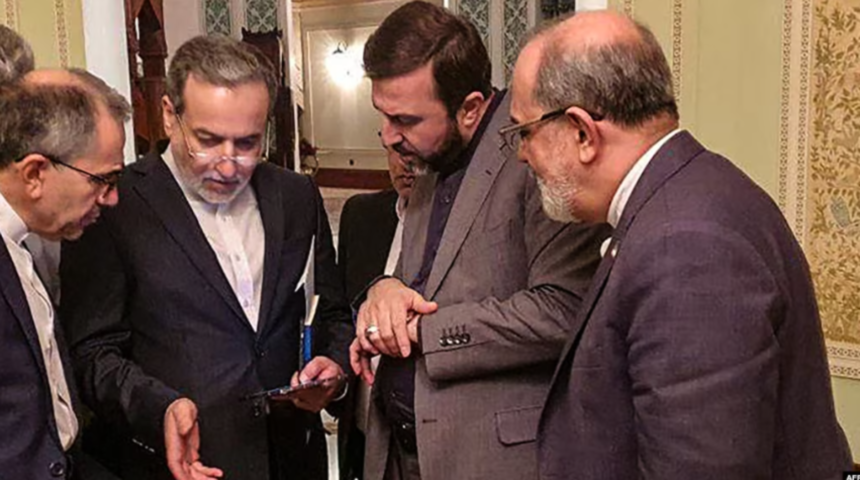Iranian and American negotiators have agreed to a second round of high-level talks on Tehran’s nuclear programs next week, following a meeting on April 12 that lasted more than two hours and was described by both sides as “positive” and “constructive.”
“The talks were very positive and constructive,” said the White House after the meeting in the Omani capital, Muscat.
It stated that U.S. Special Envoy Steven Witkoff emphasized “that he had received instructions from President [Donald] Trump to resolve the differences between our two countries through dialogue and diplomacy, if possible.”
“These issues are very complex, and Special Envoy Witkoff’s direct communication today was a step forward toward achieving a favorable outcome for both sides,” the White House added.
It further indicated that “the parties agreed to meet again” on April 19.
Later, Trump, in response to reporters’ questions about the talks, said: “I think it’s going well.”
“Nothing matters until it ends successfully, so I don’t like to talk about it. But it’s going well. The situation with Iran is going quite well, I think,” he told reporters aboard Air Force One.
The indirect meetings—mediated by Oman—are the first between officials from both countries on this issue after several years and come amid rising tensions and military threats from Washington.
Officials said the delegations were kept in separate rooms and exchanged messages via Omani Foreign Minister Said Badr.
Oman, located on the southeastern coast of the Arabian Peninsula, has served as a mediator between Iran and Western countries, including during negotiations that led to the release of several foreign citizens and dual nationals held by Tehran.
The Iranian delegation was led by Iran’s Foreign Minister Abbas Araqchi, who also stated that the parties would meet again next weekend.
Although the parties did not meet face-to-face during the talks, Araqchi briefly spoke with Witkoff—in the presence of Oman’s foreign minister—after the meeting, describing this as “diplomatic courtesy.”
Araqchi said the talks were held in a “fruitful, calm, and positive atmosphere.”
Iran’s Ministry of Foreign Affairs described the talks as “constructive.”
“[Witkoff’s] desire during the negotiations was to establish the overall framework of the agreement as soon as possible,” said the senior Iranian diplomat, referencing the first direct interaction between the two countries since the Obama administration.
A few days before the meeting, President Donald Trump warned that “if necessary,” the United States would “definitely” use military force against Iran—while Israel is ready to play a leading role in this.
Iran’s response has been defiant, suggesting that the risks are high for both countries and for the wider region as the delegations meet in Oman.
How Did It Come to This?
The talks mark another chapter in the strained relations between Iran and the United States, characterized by cycles of diplomacy and confrontation.
The 2015 nuclear agreement—officially known as the Joint Comprehensive Plan of Action (JCPOA)—once offered hope for easing tensions, but Washington’s withdrawal from the agreement in 2018 under Trump’s first term triggered a series of sanctions and uranium enrichment by Tehran.
European powers tried to save the JCPOA by launching a mechanism called the Instrument in Support of Trade Exchanges (INSTEX), which aimed to facilitate non-dollar transactions with Iran to avoid violating U.S. sanctions and prevent Iran from breaching its commitments.
In practice, only one transaction was carried out through this mechanism, which was fully abandoned in 2023.
Iran’s economy, which had benefited from the JCPOA, suffered heavily from Trump’s “maximum pressure” campaign, significantly limiting Tehran’s oil exports.
Immediately after Joe Biden’s arrival at the White House in 2021, Iran and the United States began a series of indirect talks to revive the nuclear agreement. A draft agreement was prepared by the European Union, the coordinator of the JCPOA, but it was never signed.
The talks stalled in 2022 and have remained frozen until now.
What’s at Stake?
Trump has been clear about his goal: Iran must never be allowed to have nuclear weapons. However, it remains unclear whether he wants to limit Iran’s nuclear activity or completely dismantle it.
Iran is willing to give guarantees that it does not intend to build an atomic bomb but refuses to abandon its nuclear program.
Despite efforts to show confidence and claims that it can rid itself of U.S. sanctions, Tehran urgently needs a deal.
Iran’s economy is perhaps in the worst state it has ever been, as its national currency continues to fall against the dollar. The purchasing power of its citizens continues to decline, while power outages have become a daily part of summer and winter—even though Iran is a global energy powerhouse.
For the United States, it is a priority to prevent Iran from acquiring nuclear weapons.
Iran is enriching uranium to 60% purity, which is considered near the level needed to develop weapons. It has also accumulated enough for several bombs, should it decide to do so.
Tehran insists its nuclear program is peaceful and that it has never pursued nuclear weapons. But with the Trump administration continuing to mention the possibility of military strikes against Iran’s nuclear facilities, more and more Iranian officials have hinted that the country would build nuclear weapons if forced to do so.
According to estimates, Iran could enrich enough uranium for a single bomb in less than a week and enough for several bombs within a month.
Ahead of the talks in Oman, Washington ramped up pressure even further. On April 9, the U.S. Treasury Department announced sanctions on five entities and one individual in Iran for their support of Iran’s nuclear program, including the Iranian Atomic Energy Organization (AEOI).
Mohammed Ghaedi, a professor in the Department of Political Science at George Washington University, told Radio Farda of Radio Free Europe that the new sanctions might have little impact as they target AEOI’s assets in the U.S., which are limited.
He argued that these sanctions mainly serve to increase the U.S.’s negotiating power over Iran during the talks, according to RFE.
On April 9, Trump reiterated the warning that, in the absence of a deal, the U.S. would use military force to destroy Tehran’s nuclear program.
“Israel, of course, will be very involved in this. They will be the leaders of this effort,” he said.
Ali Shamkhani, a senior advisor to Iran’s Supreme Leader Ayatollah Ali Khamenei, responded by saying that ongoing military threats would force Iran to expel UN inspectors and “move enriched uranium to secure locations.”







